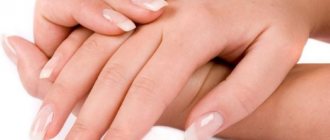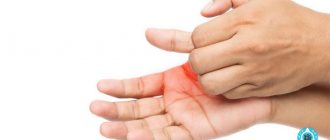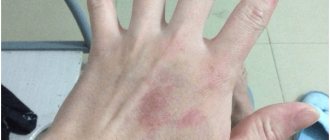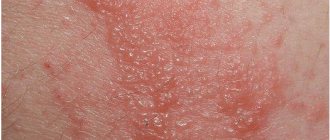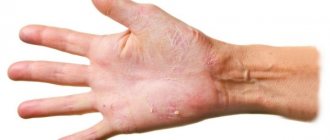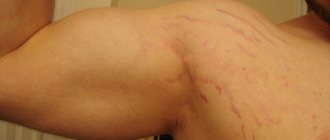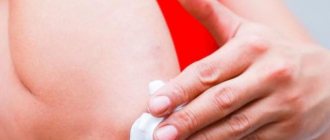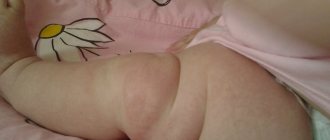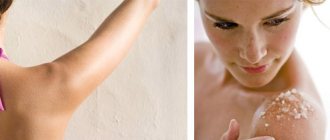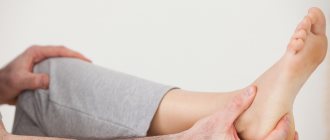The appearance of rashes and pimples on the hands causes not only aesthetic discomfort, but also physical discomfort, since it is often accompanied by severe itching and redness of the skin. Very often, itchy pimples on the hands indicate some kind of dermatological disease that requires appropriate therapy without delay. After all, many pathological conditions, if left untreated, tend to become chronic, which is much more difficult to respond to various methods of therapy.
Causes of blistering rashes on hands
A rash on the hands in the form of blisters is a fairly common phenomenon.
It can appear suddenly on any part of the body, but the areas of the face, arms and lower extremities are high-risk areas. However, the reasons for the rash can be very different. New growths come in different colors and sizes and have different structures. The liquid that fills pimples has a different consistency and shade (transparent, milky, purulent). The localization also varies: the rash affects the fingers, palms, the entire hand or the skin from the hand to the shoulder. Sometimes a rash that appears in the arm area begins to spread throughout the body.
It is worth noting that rashes may be accompanied by:
- high temperature
- sudden chills
- redness of the skin
- unpleasant itching
- runny nose, sneezing, and cough (rarely)
- general weakness
- enlarged lymph nodes.
Prevention
Following certain recommendations helps reduce unpleasant symptoms and prevent the appearance of new skin defects.
- Correction of diet . It is necessary to limit the consumption of marinades, sweets, spicy and salty foods, smoked foods, and alcoholic beverages. It is better to eat dishes stewed, boiled or steamed. Include more vegetables and fruits, herbs, fish and lean meat in your daily menu.
- Choice of clothes. It is better not to wear synthetics, giving preference to clothes and underwear made from natural materials.
- Strengthening the immune system. It is necessary to regularly take vitamin-mineral complexes, exercise, regularly be in the fresh air, and observe a work-rest regime.
The appearance of rashes on the hands is a clear sign of disorders within the body or the development of a skin disease.
Only a doctor can say exactly what caused the rash.
- Home methods and preventive measures will help reduce unpleasant symptoms.
- But medical treatment of acne on the hands should be carried out by a doctor based on the diagnosis.
Causes of rashes
A rash may be a sign of an infection, a dermatological problem, or another disease. It is a common manifestation of an allergic reaction. Therefore, it is very important to correctly determine the causes of the blistering rash and make a correct diagnosis.
Infection
There are many infections that cause rashes on the hands. This list includes such common diseases as scarlet fever, measles, rubella, erysipelas, and chicken pox.
Such diseases are considered to be childhood diseases, but they are often diagnosed in adults. It is worth considering that these diseases are contagious, and therefore require timely consultation with a doctor and a strict regime so that the patient not only quickly gets rid of the disease, but also does not become a source of infection for other people.
Allergy
The skin of your hands is constantly exposed to external influences. Contact with various objects in public places, household chemicals, cosmetics, plants - can cause a rash on the hands in the form of blisters; treatment in adults is simply necessary. Allergic reactions can also be caused by food and medications. If a rash on the hands is the result of an allergy, then, as a rule, it is accompanied by burning and itching.
Skin diseases
A rash on the hands in the form of blisters in a child is a sign of some dermatological problems, for example, dyshidrotic eczema. Fungal skin diseases, such as athlete's foot.
Prickly heat
Redness and blisters on the hands of a small child can be caused by a common heat rash, which is associated with thermal disturbances. Miliaria is not a dangerous disease and does not require special treatment. It is enough to follow the rules of hygiene and dress the baby in accordance with the temperature conditions.
Air baths, special baby powders and creams, and a warm bath made from a decoction of the string will help speed up the disappearance of prickly heat. (Small rash on the face of a baby)
Herpes (vesicular lichen)
Herpes is a viral disease that is chronic in nature, primarily affecting the mucous membranes, but an infectious exacerbation can cause a similar rash on the hands if the rash on the lips is treated with antiviral agents. (Herpes simplex virus)
Insect bites, urticaria
Blistering can be caused by insect bites or contact with burning (poisonous) plants. In the absence of allergies, such causes of rashes can be considered harmless. It is enough to lubricate the place of bites and hives with ordinary brilliant green. (What is urticaria)
Autoimmune syndrome
Blistering formations on the skin of the hands are also part of the symptoms of a dangerous and still poorly understood autoimmune disease. The reasons for the development of this disease are unknown. Doctors consider heredity to be one of the factors.
Stress
One of the causes of rashes is stress. Bubbles “from nerves” most often “sprinkle” the hands, they itch, itch, and create additional discomfort in a difficult psychological situation.
Although these rashes are associated with emotional and mental stress, treatment is not limited to sedatives. The doctor will not prescribe therapeutic treatment.
Scabies
Another reason for the appearance of small itchy pimples on the upper extremities is scabies, caused by scabies mites. This is a very contagious disease, transmitted by tactile contact, by touching the patient’s personal items. The scabies mite is extremely resistant to adverse environmental conditions, so it is quite difficult to get rid of it.
The main symptoms are a profuse small rash accompanied by painful itching, especially at night. The disease spreads very quickly, so if the skin of the hands is affected, appropriate treatment must be started immediately.
Dermatologists usually prescribe the following medications to treat scabies:
- Ivermectin;
- Sulfuric ointment;
- Zinc paste;
- Permethrin;
- Benzyl benzoate.
This disease is very dangerous in children, since scratching often causes a bacterial infection, which can result in suppuration.
What to do
When blisters appear on your hands, the main thing is not to panic. The right solution, especially if this problem is unexpected for you (no allergies or other factors), and you do not know the cause, is to visit a dermatologist.
Diagnosis of a blistering rash cannot be called simple; even an experienced doctor is not able to visually determine their cause.
In a controversial situation, the patient will have to undergo tests (skin scraping, blood, urine, etc.). This will allow you to make an accurate diagnosis and choose the optimal treatment method. Before visiting a doctor, the areas affected by the blisters are not treated with medications, especially those that stain the skin (iodine, brilliant green, potassium permanganate). These medications change the natural appearance of pimples, making it difficult to determine the cause of their appearance.
Do not scratch the affected areas, pierce or squeeze out the contents of the blisters. The liquid found in pimples, getting on healthy areas of the skin, can provoke their further spread. Wounds at the site of damaged vesicles can cause various infections to enter the body. In addition, cosmetic defects form in place of combed or opened blisters, which are difficult to get rid of.
Removing external symptoms
The only thing that can and should be taken independently is measures to alleviate the patient’s condition, to prevent the spread of the rash to healthy areas of the body, among healthy people. For these purposes, medications are used and hygienic measures are taken. The general rule when detecting symptoms is to minimize contact with other people. In addition, it is recommended:
- Refrain from scratching the affected areas.
- To reduce irritation, use cooling. A cold compress is applied to the areas adjacent to the itchy area.
- Avoid using chemically active detergents and wash your hands only with warm water.
- Pay attention to the structure of your diet, excluding alcohol, spicy, salty, caffeine. Smokers are not advised to abstain from cigarettes.
- Use ointments and creams. You can also sprinkle powder on the itching site, which will have a disinfecting effect.
This is not enough to completely get rid of the disease, but the use of these measures will significantly alleviate the patient’s condition and the recovery process.
The information on the site is provided for informational purposes only and cannot replace the advice of your attending physician.
Diseases that cause rash
Important! A chemical burn with a blistering rash can be caused by chemical household cleaning products.
- Insect bites. Typically, insect bites become swollen and red, but sometimes blisters with clear liquid form on the skin. Especially if a person has thin skin. As a rule, such blisters appear after sleep or evening walks - mosquitoes bite exposed areas of the body. Also, a person may not notice that he has received a burn from exposure to high temperatures. Blistering rashes can appear due to oil splashes during cooking, sparks hitting the skin, or trying to wash your hands with too hot water.
- Splinters. Bubbles appear due to splinters around which suppuration has accumulated. A large number of bubbles may be due to multiple small splinters. These blisters usually appear a few days after cleaning up broken glassware or woodworking. In rare cases, foreign bodies can remain under the skin for many years and then become inflamed, causing pus-filled blisters to form.
- Calluses. Sometimes the appearance of blisters on the hands is caused by mechanical damage. The skin can be rubbed by the handle of a heavy bag, a rough cloth when squeezing out a cloth, and so on. The size of the calluses may vary, they can cause mild pain, but there should not be itching or an unpleasant odor. In this case, the skin on the blisters is rougher and harder, and a cloudy liquid is observed inside.
Diagnostics
If a spot on your hand itches and peels, this is a reason to think about your health. You definitely need to see a dermatologist. Especially if the problem concerns a child. A child's body is more sensitive and susceptible to pathogens, and it is equally difficult to cure them, big and small.
First, the doctor conducts an examination and asks about your lifestyle a few days before the visit: what you ate, what environment you were in, what medications you took. After this, he prescribes laboratory tests and diagnostics using medical equipment:
- blood sampling for general examination and biochemistry;
- immunological study;
- allergen identification test;
- scraping from the affected area of skin;
- Ultrasound of internal organs.
READ ALSO: Antiandrogens: drugs for women
If the doctor finds it difficult to make a correct diagnosis and has unanswered questions, the patient is sent for additional examination in a hospital setting. The doctor will prescribe treatment only after making a diagnosis.
If the patient is taking any medications at this time to relieve symptoms, the doctor must be notified about this.
Symptoms
A blistering rash on the hands can be different: in the form of transparent blisters or in the form of red rashes, in the form of weeping or, conversely, dry. The sizes of the bubbles also differ: they can be very small or large, the size of a pea or even larger. The liquid with which the bubbles are filled can also be of different shades: completely transparent or purulent, milky. The blisters may become covered with crusts or scales, increase in size and quantity, or may remain unchanged. When making a diagnosis, the localization of the rash is also of great importance: it can be located, for example, only on the fingers or along the entire arm from the hand to the forearm.
In addition, the rash rarely appears on its own. It is often accompanied by the following accompanying symptoms:
- increased body temperature;
- itchy skin;
- skin redness;
- chills;
- runny nose and sneezing;
- rarely – cough;
- stool disorders;
- swollen lymph nodes;
- general weakness.
Reasons for appearance
A rash on the hands in the form of blisters can be a symptom of an infectious, dermatological or other disease. It may also be a sign of an allergic reaction. Here are the main reasons for the appearance of such rashes.
Infection
Scarlet fever, rubella, measles, chicken pox - there are a lot of possible diagnoses. Mostly young children suffer from such diseases, but it is possible that the infection can also affect the body of an adult. All infectious diseases are similar to each other, but they are transmitted differently. For example, with chickenpox a person feels quite normal and does not need special treatment. Scarlet fever, on the contrary, must develop under the careful attention of a doctor, otherwise a serious complication may arise. To make an accurate diagnosis, be sure to consult your doctor, or better yet, call an ambulance. Infectious diseases are contagious, and by going to the hospital in person, you inevitably endanger the health of those around you.
Allergic reaction
It is with our hands that we most often come into contact with the objects around us. So, an allergy may appear after you have cleaned using household chemicals with your bare hands without gloves. Even metal that you have touched can be an allergen. Allergies cannot always be only contact allergies. An allergen can be a food product, a medicine, unsuitable or spoiled cosmetics. If the rash only appears on your fingers, you may be allergic to nail polish. This reaction happens to gel polish, which is often used to cover nails in beauty salons today. It is not of high quality everywhere. If the rash on your hands in the form of blisters appears precisely because of an allergy, most likely you will feel itching and burning of the skin.
Autoimmune diseases
In some cases, this rash may be a symptom of a very dangerous autoimmune disease. Doctors still don’t know exactly why they occur. The hereditary factor plays a major role, but this is not the only reason for the development of such diseases. Among the possible diagnoses in which a blistering rash may appear on the hands are bullous pemphigoid, dermatitis herpetiformis, and pemphigus.
Stress
It is on the hands that rashes most often appear due to stress. These rashes are itchy and itchy. Despite the fact that they appeared precisely because of psycho-emotional stress, the treatment of such rashes will not only come down to the use of sedatives. Local therapy will also be required. The attending physician will tell you which one.
Dermatological diseases
A blistering rash may be a sign of a dermatological disease. For example, this may be a symptom of dyshidrotic eczema. Dermatological diseases of a fungal nature can also appear in the form of blisters. One of these is, for example, epidermophytosis.
Prickly heat
If a rash in the form of blisters appears on the hands of a small child, in addition to infectious diseases, it may well turn out to be miliaria. Miliaria is a harmless disease that does not require special treatment. It occurs due to increased skin moisture. Perhaps the child was wrapped too tightly before going outside, causing him to sweat. It is possible that he has been in the same diapers at home for too long, which is why diaper rash appears on his skin.
You can cure the heat rash by giving the child long air baths, using various powders and creams, and bathing the baby in a decoction of the string.
Itchy
Water blisters can itch in different ways:
- All day.
- Sometimes it appears regularly or at a certain point in the day.
- Often appears at night, as if under the skin.
At the same time, you need to remember that scratching them is prohibited; a damaged vesicle, and as a result, the skin, will cause the development of inflammatory processes caused by infection. This leads to serious diseases of the skin and joints. It is dangerous if cracks begin to appear.
It is better not to touch the skin rash at all, but if the condition seems unbearable, interferes with sleep or is difficult to perform basic operations, you can use different ointments. But before using any medications, it is better to consult a doctor.
Traditional medicine recommends using cold compresses using medicinal herbs and baking soda. But still, only visiting a specialist is a good choice for severe itching.
What to do if a rash in the form of blisters appears on your hands?
There are many possible diagnoses, so to establish the exact cause you need to see a doctor and undergo all the necessary tests. It happens that even a doctor cannot immediately determine what exactly was the provoking factor. In this case, you need to do an analysis of the contents of the bubbles; the doctor may take a skin scraping and refer you for a blood and urine test.
Under no circumstances should you scratch the blisters or try to squeeze them out, puncture them, or open them in any other way. If the fluid contained in the blisters gets on healthy areas of the skin, the rash may spread to them. In addition, if you open the bubbles, a small scar may then remain in their place, which will be very problematic to eliminate.
First aid
If a bubble that suddenly appears on the skin does not cause severe discomfort, it is best to leave it alone and not touch it. As already mentioned, the liquid inside the blister protects the damaged skin and prevents infection. Therefore, the best option is to let the blister go away on its own.
A small bubble can be sealed with a special adhesive plaster, which can be purchased at any pharmacy. It is better to cover a relatively large blister with gauze, which allows the skin to breathe and also absorbs moisture well.
If the resulting bubble causes severe discomfort, you can reduce the pain by releasing the fluid from it. This is done as follows:
- First, you need to wash your hands thoroughly with soap.
- The area where the blister is located should be disinfected with alcohol or chlorhexidine.
- You need to take a sharp needle and wipe it with alcohol.
- The blister should be pierced with a needle in several places along the edge. The liquid must be allowed to drain. But the skin covering the wound should not be removed.
- Then a special antibacterial ointment is applied to the damaged area, and a gauze or bandage bandage is applied on top.
- After a couple of days, the condition of the blister should be checked. Dead skin should be carefully removed using scissors and tweezers (necessarily sterilized). The damaged area must be lubricated again with antibacterial ointment. A gauze bandage is again applied on top.
Attention! People with diabetes or poor circulation should not open the blister on their own. In this case, it is better to go to a clinic, where a specialist will competently carry out the necessary procedure.
Etiology
A watery rash may appear on the skin in the following cases:
- Sunburn, in which, 5 to 8 hours after sunbathing, the skin becomes hot, red and itchy, and then becomes covered with water blisters.
- Chicken pox - in this case, the blisters are the result of infection with viruses. This disease is mainly diagnosed in pediatric patients, but it is also registered in adults. First, watery pimples are observed, which quickly fill with purulent exudate and subsequently become covered with a crust. In addition to rashes, the patient's temperature, general weakness and chills are recorded.
- Shingles - a blistering rash accompanied by hyperthermia, severe itching and burning. It appears as a result of exposure to the body of herpes viruses, which can infect nerve endings.
- Contact allergy - when interacting with an allergen, rash elements may appear on the skin within a few minutes. Before the blisters appear, the surface of the skin becomes red and itchy.
- Fungal infections.
- Excessive sweating of the skin.
- Applying a temporary tattoo with black henna, which contains paraphenylenediamine.
Other causes of the appearance of a rash in the form of blisters also include pemphigus, dermatitis herpetiformum, and bullous pemphigoid. On the fingers, such pathological elements mainly indicate the development of dermatitis. Favorable factors for its development are overwork, poor nutrition and constant stress.
Allergic dermatitis is a consequence of increased sensitivity to certain medications, household chemicals or cosmetics. Contact dermatitis usually develops with constant trauma to the skin, as well as with a chemical or thermal burn. Blistering rashes may indicate disturbances in the functioning of internal organs, the development of eczema, local bacterial infection, as well as the presence of pathologies of the nervous and endocrine systems, and vascular lesions.
A rash in the form of blisters is also characteristic of dyshidrosis. This is a skin lesion in which the sweat glands become clogged, which in turn is accompanied by the appearance of blisters. They itch constantly. The palms, fingers and toes are most often affected. The rashes are filled with serous fluid, when pathogenic microorganisms penetrate, pustules form, and the affected area swells and turns red. Skin rashes can be a reaction of the immune system to certain substances or toxins, when exposed to which the so-called toxic epidermal necrolysis develops. It manifests itself as an erythematous rash and necrolysis of the skin followed by the appearance of blisters.
Sources of discomfort
Blistering and itching can occur for various reasons. Favorable conditions for their appearance are: neglect of hygiene requirements, microtrauma of the skin, reduced immunity due to congenital or acquired diseases. In the latter case, rashes and accompanying itching are most often associated with:
- allergic reactions,
- scabies mite,
- autoimmune diseases,
- fungal infection
- we deprive.
Allergic reaction
Often, a rash and the itching between the fingers that it provokes occur as a reaction of the body to the action of external irritants. It can manifest itself in an apparently healthy person against the background of decreased immunity, and is typical for carriers of various diseases. Its external symptoms are:
- characteristic bubbles in the interdigital space;
- the skin along the entire hand from wrists to fingertips begins to peel and itch;
- itching is accompanied by redness.
For obvious reasons, the hands most often come into contact with various substances, making them the most vulnerable part of the body to various allergens. The latter can be:
- household detergents;
- various types of cosmetics;
- hair from pets;
- tight gloves, the presence of synthetic materials in them;
- some types of products.
The reaction can be immediate, delayed or delayed, depending on the type, the first symptoms appear in the range from a few minutes to two days. Acute itching prompts you to scratch its foci, which complicates the course of the disease and can cause additional infection.
Itchy irritation
A parasitic form, the causative agent of scabies is a mite. The cause of irritation is the passages made in the skin, where the parasite leaves waste products. Infection occurs through direct contact with a carrier, for example, through a handshake. With the first infection, symptoms appear after four weeks, secondary infection occurs faster, characteristic symptoms are detected within 24 hours. Signs of scabies are:
- scabies are clearly visible;
- the appearance of papules (nodules) and vesicles (blisters with clear liquid);
- redness of the skin at the site of the lesion;
- severe itching, when not only the affected area itches, but also the entire finger, the entire hand.
When scratching, pustular formations form due to staphylococci and streptococci. Diagnosis is made by analyzing skin material obtained by scraping.
Autoimmune diseases
In this case, the rash is a manifestation of systemic diseases that affect a separate organ or group. Due to gene mutations, external infections, physical influences (radiation, sunburn), lymphocytes begin to destroy blood proteins, reducing immunity. Such diseases include
- articular,
- endocrine,
- nervous,
- liver,
- renal,
- blood,
- pulmonary, etc.
One of the symptoms is rashes, dry skin and a characteristic desire to scratch the area of irritation. For a complete recovery, comprehensive treatment is necessary, eliminating not only the disturbing symptoms, but also the underlying cause.
Fungal infection
Interdigital fungal infection, a rare form of localization. More often, the fungus spreads throughout the hand. At the initial stage it is almost invisible visually and in sensations. Gradually, small blisters form on the skin, which develop into continuous lesions with pronounced peeling and characteristic discomfort. The resulting cracks are accompanied by a strong burning sensation. Infection is possible when:
- handshake;
- using contaminated gloves;
- other people's manicure accessories;
- poorly disinfected instruments in beauty salons;
- toys, towels, bed linen;
- being in a bathhouse or swimming pool;
- scratching feet affected by fungus.
The likelihood of fungal infection increases with non-compliance with hygiene requirements and the presence of endocrine problems, cracks in the skin, and reduced immunity. It is difficult to identify the disease by external signs; the external symptoms of the fungus are comparable to other skin diseases. Diagnosis is made by scraping taken from the infected area.
Ringworm infection
Redness, peeling and itching may be signs of lichen damage to the skin. Refers to contagious infectious diseases that are transmitted by contact. Carriers or sources of infection can be:
- other people or animals;
- neglect of hygiene rules;
- using things of an infected person;
- frequent interaction with chemicals.
Factors that facilitate the formation of fungal infections are reduced immunity, disrupted hormonal levels, and increased stress on the nervous system. There are quite a few variants of deprivation, the most dangerous forms for the hands are:
- pink,
- red flat,
- color.
A qualified dermatologist will be able to correctly determine the type of infection; based on the diagnostic results, the optimal set of drugs and treatment system will be prescribed.
Dry skin
The cause of concern may be simple dry skin. Compared to the others, this is not the worst problem, although the level of discomfort is comparable. Frequent, careless scratching may lead to infection and complications. To avoid such problems and relieve itching, it is recommended to use moisturizing and firming creams. In addition to medications, it is necessary to warm your hands in winter, which will protect the skin from drying out by cold and wind. If discomfort persists, a more serious illness may be present, which can only be determined by examination at a medical facility.
Features of treatment of vesicular rash
Therapeutic tactics depend on the etiology of the skin rash. In some cases, topical medications are sufficient, in others, only the prescription of systemic medications allows one to avoid complications and restore the normal condition of the skin. If the blisters are allergic, patients are bothered by severe itching. The skin on the palms thickens, becomes excessively dry, and cracks may appear, so you need to protect your hands as much as possible from damaging external factors (cosmetics, household products, mechanical injuries, etc.).
To eliminate the main manifestations of skin allergies, antihistamines are prescribed. In treatment, it is important to exclude the influence of the allergen and adhere to a special diet (it is recommended to exclude from the diet sweets, exotic fruits, mushrooms and nuts, as well as foods that contain a lot of dyes and food additives). In severe cases, intravenous infusions of calcium chloride are prescribed. To reduce itching, sedative therapy is carried out (drugs based on valerian or peony root are prescribed). Vitamin therapy has a positive effect (especially taking B vitamins, retinol and vitamin E). To more quickly remove allergens from the body that provoke a skin reaction, it is recommended to take enterosgel, polysorb or another sorbent. In the absence of positive dynamics, treatment with GCS is carried out. In case of concomitant bacterial infection, antibiotics are prescribed.
When a herpetic or fungal infection is added, the treatment plan must include antiviral drugs or antimycotics. When neurodermatitis develops, sedatives are prescribed. Psychotherapy sessions are helpful. Skin rashes are often the result of problems with the gastrointestinal tract, endocrine system, and are also a sign of hormonal disorders, so for effective treatment it is necessary to treat all concomitant diseases.
If the rash on the hands is a consequence of dyshidrosis, it is recommended to apply fucorcinol, zinc ointment or resorcinol solution topically. It is useful to make baths with soda, a decoction of oak and celandine. If signs of inflammation appear, antibiotic ointments are prescribed. In severe cases, drugs with corticosteroids should be used. As a rule, they use products that contain hydrocortisone and prednisolone (for example, Lokoid). In addition to pharmacological treatment, physiotherapy is carried out (ultraphonophoresis with appropriate medications, endonasal electrophoresis, ozone and laser therapy, and diadynamic currents are also used).
For toxic epidermal necrolysis, treatment is similar to treatment for burns. They carry out infusion detoxification, correct hypovolemia, and ensure maximum sterility of everything that surrounds the patient. Local lotions are made with antiseptic solutions, ointments with glucocorticoids are applied, and antihistamines and protease inhibitors are prescribed systemically. If necessary, plasmapheresis or hemosorption is performed.
How to treat
Methods for treating acne on the hands depend on the causes of their appearance.
To determine the main provoking factor, you will need the help of a dermatologist.
Photo: in order for the doctor to prescribe effective treatment, it is necessary to establish the cause of the rash
After making an accurate diagnosis, the specialist will tell you how to get rid of the rash on your hands quickly and without unwanted consequences.
- Allergic rash. The main condition for treating allergies is identifying the allergen and eliminating contact with it. Drug treatment includes taking antihistamines (Suprastin, Cetrin, Zodak, Tavegil). Hormonal ointments based on glucocorticosteroids can also be prescribed.
- Folliculitis. For folliculitis, local use of antiseptics is prescribed, and in the case of a chronic form of the disease, antibiotics from the group of tetracyclines, cephalosporins and macrolides are prescribed internally.
- Avitaminosis. If white pimples on the hands are the result of a lack of vitamins and minerals, complexes with a high content of vitamins A, E, C, and group B are prescribed.
- Exchange disorders. In case of metabolic disorders, treatment of the underlying disease is necessary. Dysbacteriosis is treated with means to restore normal intestinal microflora (Lactiale, Linex, Bifi-Form, Hilak). Sorbents (Polysorb, Enterosgel, Polyphepan, activated carbon) help cleanse the body of the accumulation of toxins.
- Hormonal imbalance. Rashes in women that are caused by pregnancy, as well as teenage acne, go away on their own after stabilization of hormonal levels. If fluctuations in hormones in the body are caused by diseases of the endocrine and reproductive systems, the underlying pathology is treated.
- Scabies. Treatment comes down to the destruction of the pathogenic mite using special means for topical use (benzyl benzoate emulsion, sulfur ointment, Spregal spray).
- Purulent acne. To accelerate the maturation of a pimple and the release of pus, ichthyol or Vishnevsky ointment and other creams with antibacterial components are used.
- Dyshidrosis. The underlying disease that caused the problem is treated. Additionally, sorbents (Enterosgel, Polyphepan) are prescribed to cleanse the body of waste and toxins and drugs that normalize metabolism.
- Hyperkeratosis. Treatment is based on the use of ointments based on retinoids and glucocorticosteroids.
It is important to understand that self-medication does not always result in recovery.
Due to the wrong choice of medications, therapy may not be effective, and in the worst case, it will lead to aggravation of the problem and the development of complications.
At home
At home, you can supplement drug treatment:
Photo: Herbal baths soothe the skin
- baths or lotions with herbal infusions and decoctions (chamomile, string, calendula, oak bark, wild rosemary, clover) - effectively eliminate inflammation and irritation;
- baths with a solution of potassium permanganate - disinfects, eliminates itching and a feeling of dryness;
- treating problem areas with a solution of salicylic acid, calendula tincture, hydrogen peroxide, herbal decoctions - helps relieve itching, burning, redness;
Photo: peeling cleanses the skin and helps remove dead cells
- peeling with sea or regular table salt - cleanses the skin of the upper keratinized cells.
Folk recipes
Photo: clay dries out rashes
- Cosmetic clay. Dilute white or blue clay with water to a creamy consistency. Apply the mixture to problem areas, and after drying, rinse with water. Wipe the skin with herbal decoction. Clay dries out pimples well and reduces inflammation.
- Aloe leaf juice. Place aloe leaves for 10 days in a cool, dark place, then chop and squeeze out the juice. Wipe problem areas with the product up to 3 times a day. The juice helps with skin irritation and acne inflammation.
Photo: aloe juice has an anti-inflammatory effect
- Decoction of birch buds. Pour a tablespoon of raw material into a glass of boiling water, boil for 20 minutes, leave and strain. Use for lotions and compresses.
- Apple vinegar. Dilute the product with an equal amount of warm water and use to wipe problem areas twice a day.
Oral preparations
To treat acne on the hands and body, herbal decoctions and infusions can be used not only externally, but also internally.
- Nettle infusion. Pour a tablespoon of herb into a glass of boiling water, leave for a couple of hours, strain. Take ½ glass three times a day before meals. The course of treatment is a month. This remedy is especially effective in the fight against hormonal acne, which appears in men, women and adolescents due to physiological changes or disruptions caused by diseases of the endocrine and reproductive systems.
- Dandelion decoction. Pour a tablespoon of crushed plant roots into a glass of boiling water and boil for several minutes. Infuse, strain. Take 1/3 cup three times a day. The product copes well with inflamed purulent acne.
- Burdock root decoction. Pour a tablespoon of raw material into a glass of boiling water and boil. Infuse, strain. Take 1/3 cup 4 times a day, regardless of meal time.
READ ALSO: Pimple on an intimate place in women - a wen, a white, purulent pimple on the labia
Photo: to treat acne, you can take herbal infusions and decoctions orally

